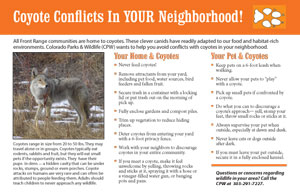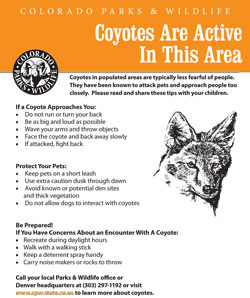Living with Coyotes in Colorado
Perhaps no other wild animal has endured the wrath of humans while evoking such genuine heartfelt admiration quite like the coyote. Some people curse their existence; Native Americans consider them to be the smartest animal on earth, calling them “God’s dog”, and many urbanites revel in opportunities to see and hear these vocal predators.
The coyote’s success is attributed to the coyote’s own ability to adapt. Coyotes have adjusted very well to human-disturbed environments, and now thrive in close proximity to people.
Coyotes are opportunistic hunters. They prey on small mammals, domestic pets, livestock, and domestic fowl but will also readily eat carrion and plants. A coyote will adjust its diet depending on the food that is available. In Colorado, coyotes are classified as a game species and may be taken year-round with either a small game or a furbearer license. Landowners may kill coyotes, without a license, on their land if the coyotes threaten their property or livestock.
Humans can coexist with coyotes. The following guidelines can help you and your family to be Coyote Wise whether you live or recreate in Coyote Country.
Coyotes are Active in this Area
All Front Range communities are home to coyotes!
Coyotes in populated areas are less fearful of people. They have been known to attack pets and approach people too closely.
Your Home & Coyotes:
-
Never Feed Coyotes!
-
Remove attractants from your yard, including pet food, water sources, bird feeders, and fallen fruit.
-
Secure trash in a container with a locking lid or put trash out on the morning of pick up.
-
Deter coyotes with a 6 foot privacy fence.
-
Never approach wildlife. If a coyote approaches, yell, throw rocks or sticks at it, spray with a hose, or bang pots and pans.
If a Coyote Approaches You:
-
Do not run or turn your back

-
Be as big and loud as possible
-
Wave your arms and throw objects
-
Face the coyote and back away slowly
-
If attacked, fight back
Protect Your Pets:
-
Keep pets on a short (6-foot) leash
-
Use extra caution dusk through dawn
-
Avoid known or potential den sites and thick vegetation
-
Do not allow dogs to play or interact with coyote
-
Pick up small pets if confronted by a coyote.
-
Always supervise your pet when outside, especially at dawn or dusk.
-
Never leave cats or dogs outside after dark.
-
Don’t leave pet food outside.
-
If you must leave your pet outside, secure it in a fully enclosed kennel.
Be Prepared!
If you have concerns about an encounter with a coyote:
-
Recreate during daylight hours.
-
Walk with a walking stick.
-
Keep a deterrent spray handy.
-
Carry noise makers or rocks to throw.

Additional Resources
- Living With Coyotes brochure
- Protect Your Pets Flyer
Questions or Concerns?
If you are experiencing problems with coyotes, or simply have questions, contact us either by phone or e-mail.
If you have an emergency situation involving coyotes, contact the nearest Colorado Parks and Wildlife office, Monday-Friday, during regular business hours. Outside normal business hours, contact the Colorado State Patrol or your county’s sheriff’s office.









